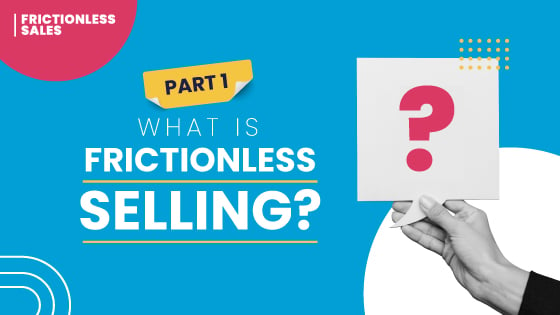






What is frictionless selling?
Nowadays, how you sell is becoming just as important as what you sell.
In fact, some companies that offer arguably inferior products are outperforming the competition based pretty much entirely on offering a more convenient way of buying things.Dollar Shave Club is a prime example of this.
Compared to a "market leader" like Gillette, Dollar Shave Club's actual product is pretty basic.
But the convenience of having razors delivered to your door rather than having to go out to a store and buy them from a shop means Dollar Shave Club has become one of the biggest competitors on the market.
This type of "frictionless selling" and removing any barriers that might make it hard for people to buy from you, and making convenience as important as the product, has completely changed how companies sell to people.
In a world where buyers have more choice than ever, and more information at their fingertips than they know what to do with, removing reasons for them not to buy from you and creating a frictionless buying experience is essential.
If you do it right, changing towards a more frictionless selling model can increase conversion rates, reduce the selling cycle, and reduce the cost of getting new customers-all of which are a great benefit to any business.
It's also way better for customers.
When you're trying to buy something, especially if it's a big investment, any company that makes it harder for you to buy from them is probably going to be at the bottom of your list.
Those which give you everything you need to make a decision when-and how-you want it are the ones you're going to go with.
3 stages of frictionless selling
You can break frictionless selling down into three parts:
1. Enabling your sales team to spending more time selling.
2. Aligning your selling process with your customer's buying journey to improve service.
3. Transforming your sales figures through a culture of learning.
Enable your sales team to sell better
To do this, you first need to figure out how they're currently selling, and what the experience is like for customers trying to buy from you.
From a sales team perspective, you could make them more productive by automating many of the repetitive tasks they have to do everyday like general admin or inputting data.
Even just cutting back on the amount of internal meetings they have to attend could make them more productive and give them more time to sell.
This time to sell is something many teams are short of. According to research by HubSpot, sales reps only spend a third of their time on average actually selling.
Align your sales process around frictionless selling
Aligning your sales process is among the more important things you need to do. Map out buyer journey your prospects go on, and figure out how you are engaging with them at each stage. Are you able to meet their needs at every stage and keep them moving? Or is there for potential for friction?
Getting an understanding of these points means you can improve your sales process and increase your chances of making a sale.
For instance, is your sales team available for prospects when the prospect wants to get information? Or do prospects have to wait? Using conversational tools like chat bots could help here.
Transform your sales team into a frictionless selling machine
Finally, you need to transform your sales culture and ensure your team is being coached to engage effectively with prospects and be a source of useful information, rather than just pushing the hard sell all the time.
This is particularly important given that research by HubSpot claims that 60% of B2B buyers distrust the integrity of salespeople. So there is work to be done to overcome this natural distrust.
If you have a large sales team, you can encourage this culture shift by getting a smaller group to adapt to your new way of working, and when everyone else sees how successful this new method is they'll quickly want to get involved.








